What Is A
Geothermal Heating System?
There are four basic types of geothermal heating system. All are ground loop systems.
Three of them are closed-loop systems, meaning that the heat exchange fluid is completely contained and circulated within the pipe system.
The fourth type of system is the open-loop option which, as the name suggests, draws water in and expels it back to its source.
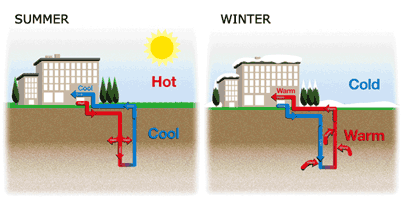
Which of these is best to use for each situation depends on the climate, soil conditions, available land, and local installation costs at the site.
All of these approaches can be used for residential and commercial building applications.
Closed-Loop Systems
Horizontal
This type of installation is generally most cost-effective for residential installations, particularly for new construction where sufficient land is available. It requires trenches at least 1.5 metres deep.
The most common layouts either use two pipes, one buried at 2 metres, and the other at 1.5 metres, or two pipes placed side-by-side at 1.5 metres in the ground.
The coiled method of looping pipe allows more pipe in a shorter trench, which cuts down
on installation costs and makes horizontal installation possible in areas it would not be with conventional horizontal applications.
The illustration of a horizontal closed loop system shows the tubing leaving the house and entering the ground, then branching into three rows in the ground, with each row consisting of six overlapping vertical loops of tubing.
At the end of the rows, the tubes are routed back to the start of the rows and combined into one tube that runs back to the house.
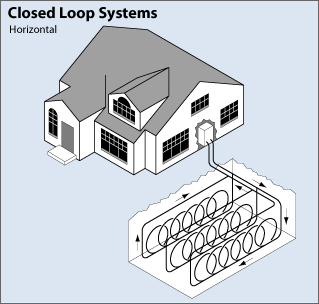
Vertical
Large commercial buildings and schools often use vertical systems because the land area required for horizontal loops
would be prohibitive.
Vertical loops are also used where the soil is too shallow for trenching, and they minimize the disturbance to existing landscaping.
For a vertical system, holes (approximately 10cm in diameter) are drilled about 20 feet apart and 30-120 metres deep.
Into these holes go two pipes that are connected at the bottom with a U-bend to form a loop. The vertical loops are connected with horizontal pipe (i.e., manifold), placed in trenches, and connected to the heat pump in the building.
The illustration of a vertical closed loop system shows the tubing leaving a building and entering the ground, then branching off into four rows in the ground.
In each row, the tubing stays horizontal except for departing on three deep vertical loops. At the end of the row, the tubing loops back to the start of the row and combines into one tube that runs back to the building via pex manifolds.
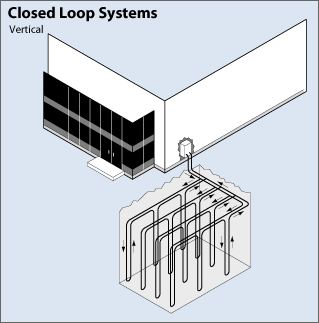
Pond/Lake
If the site has an adequate water body, this may be the lowest cost option.
A supply line pipe is run underground from the building to the water and coiled into circles at least 2 metres under the surface to prevent freezing.
The coils should only be placed in a water source that meets minimum volume, depth, and quality criteria.
The illustration of a pond or lake closed loop system shows the tubing leaving the house and entering the ground, then extending to a pond or lake.
The tubing drops deep into the pond or lake and then loops horizontally in seven large overlapping loops, then returns to the water's edge, extends up near the surface, and returns back to the house.
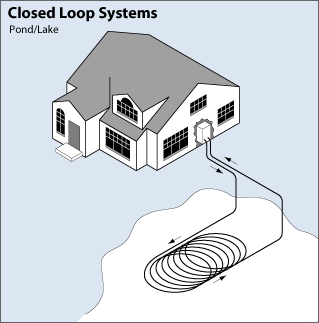
Open-Loop Geothermal Heating System
This type of system uses well or surface body water as the heat exchange fluid that circulates directly through the geothermal heating system. Once it has circulated through the system, the water returns to the ground through the well, a recharge well, or surface discharge.
This type of geothermal heating system is practical only where there is an adequate supply of relatively clean water, and all local codes and regulations regarding groundwater discharge are met.
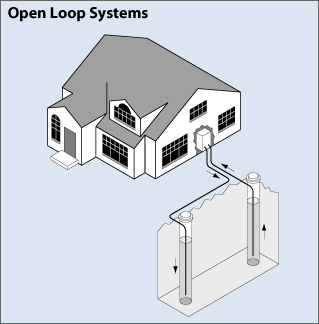
Return From Geothermal Heating System To Home Page